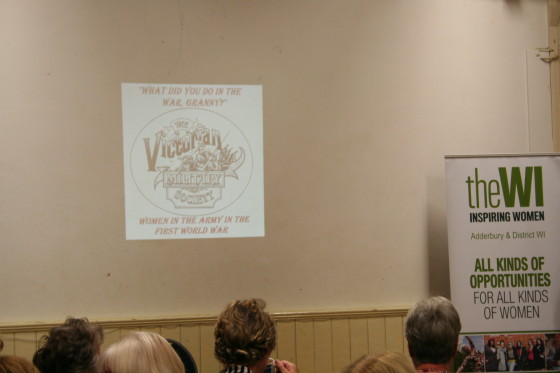
Our Guest Speaker for tonight, Dan Allen, presented a most memorable and fascinating entree into the war-time life and work of the women of World War One with fact, figures and prized photographs which tell their story without a single word. The picture tells it all.
His display of factual knowledge was brilliant as was the content and I for one was riveted by his words. We were expecting Women’s Organisatons in WWI but that was not to be, had never been intended. Instead we were presented with a question – “What did you do in the war, Granny?”. Dan’s response was a detailed listing and description of the many types or organisations women of the day managed to find their way into, were encouraged to join or set-up and encouraged other like-minded women to join. Women of all ranks and all walks of life found themselves doing work not encountered before, facing up to the reality of war-time life and getting on with matters as best they knew how to or were instructed to do.

“What did you do in the War, Granny?” was the question posed by Dan Allen in his talk on Women’s Organisations of WWI and his very interesting response was a well-documented and researched list of a variety of entities which could be joined by women of all classes, depending on your position in society and life. Almost all voluntary, all unrecognised by the government until about 1918 but all determined to do their bit for the war effort, here is my brief list of those mentioned…
WRENS – Women’s Royal Naval Service
WRAF – Women’s Royal Air Force
Joint British Army Nursing Service of 1881 – before this date, no “official” nursing service, the Corps traced its heritage back to Florence Nightingale.
QAIMNS – Queen Alexandra’s Imperial Nursing Service of 1902 – established by Royal Warrant, which replaced the Army Nursing Service, established in 1881, and which from 1889 provided Sisters for all Army hospitals with at least 100 beds. In 1949 the QAIMNS became a corps in the British Army and was renamed as the queen Alexandra’s Royal Army Nursing Corps
Queen Alexandra’s Royal Army Nursing Corps
The Territorial Army Nursing Service in 1908
British Red Cross and the St. John’s Ambulance Brigade Volunteers
VADS – Voluntary Aid Detachments for women and men, later on. Famous VADS – Vera Britten and Agatha Christie
The FANY’s – First Aid Nursing Yeomanry – The Princess Royal’s Volunteer Corps of 1907. Not part of any official body then, it is still relevant in the 21st century and tackling different types of work for a different need. They came into existence to “nurse soldiers where they fell, men dying without need…being transported to field hospitals”.
The Women’s Sick and Wounded Corps (2nd part of the FANY’s)
The Women’s Emergency Corps of 1914
Women’s Reserve
Scottish Women’s Hospital – Maud Inglis in Serbia and Russia who died of pneumonia the day after her return home in 1917
WAF – Women’s Auxiliary Force of 1915 – an entirely voluntary organisation for part-time workers
The Women’s Legion of 1915 – launched by Lady Londonderry – largest entirely voluntary body which supplied workers for many war needs including army cooks, servants etc. from large body of domestic work-force of the day. Later on workers were paid by Londonderry Family private funds.
WAAC – Women’s Army Auxiliary Corps of 1917
Women’s Forestry Corps – work done by Lumber Jill’s – with photographic evidence
Women’s Forage Corps of 1915
Women also worked as “munitionetts” in munition factories, as police officers, as bus conductresses, ticket collectors, porters, carriage cleaners and bus drivers, in childcare nurseries and wherever they could to release more men to go to “the front”. It took 57,000 women to free-up 42,000 men, working as – telephonists, store-keepers, drivers etc.
So Granny could have worked in very many situations, enjoyed freedom from parental or family control, experience new and different situations, travel overseas and, depending on her family background encounter a much wider social mix and its camaraderie.
Margaret Halstead.


